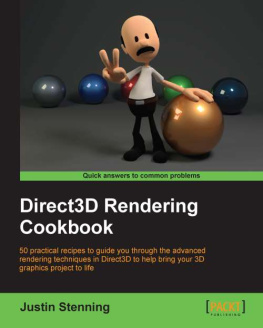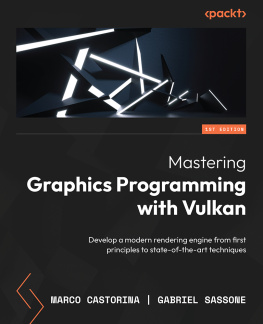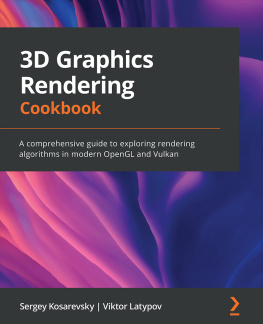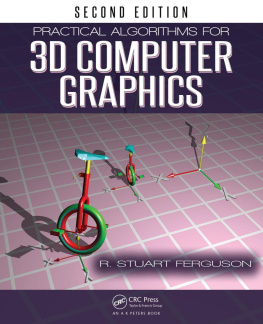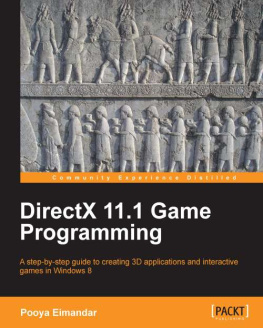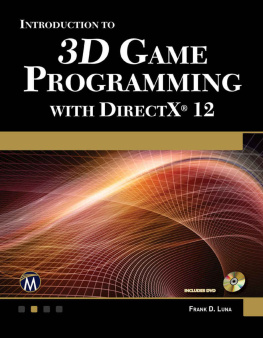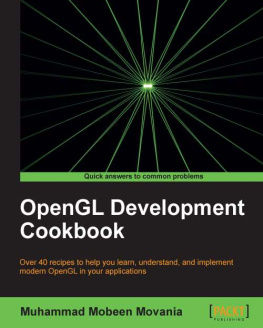Justin Stenning - Direct3D Rendering Cookbook
Here you can read online Justin Stenning - Direct3D Rendering Cookbook full text of the book (entire story) in english for free. Download pdf and epub, get meaning, cover and reviews about this ebook. year: 2014, publisher: Packt Pablishing, genre: Home and family. Description of the work, (preface) as well as reviews are available. Best literature library LitArk.com created for fans of good reading and offers a wide selection of genres:
Romance novel
Science fiction
Adventure
Detective
Science
History
Home and family
Prose
Art
Politics
Computer
Non-fiction
Religion
Business
Children
Humor
Choose a favorite category and find really read worthwhile books. Enjoy immersion in the world of imagination, feel the emotions of the characters or learn something new for yourself, make an fascinating discovery.
- Book:Direct3D Rendering Cookbook
- Author:
- Publisher:Packt Pablishing
- Genre:
- Year:2014
- Rating:3 / 5
- Favourites:Add to favourites
- Your mark:
Direct3D Rendering Cookbook: summary, description and annotation
We offer to read an annotation, description, summary or preface (depends on what the author of the book "Direct3D Rendering Cookbook" wrote himself). If you haven't found the necessary information about the book — write in the comments, we will try to find it.
Overview
Learn and implement the advanced rendering techniques in Direct3D 11.2 and bring your 3D graphics project to life
Study the source code and digital assets with a small rendering framework and explore the features of Direct3D 11.2
A practical, example-driven, technical cookbook with numerous illustrations and example images to help demonstrate the techniques described
In Detail
The latest 3D graphics cards bring us amazing visuals in the latest games, from Indie to AAA titles. This is made possible on Microsoft platforms including PC, Xbox consoles, and mobile devices thanks to Direct3D a component of the DirectX API dedicated to exposing 3D graphics hardware to programmers. Microsoft DirectX is the graphics technology powering all of todays hottest games. The latest version DirectX 11features tessellation for film-like geometric detail, compute shaders for custom graphics effects, and improved multithreading for better hardware utilization. With it comes a number of fundamental game changing improvements to the way in which we render 3D graphics.
Direct3D Rendering Cookbook provides detailed .NET examples covering a wide range of advanced 3D rendering techniques available in Direct3D 11.2. With this book, you will learn how to use the new Visual Studio 2012 graphics content pipeline, how to perform character animation, how to use advanced hardware tessellation techniques, how to implement displacement mapping, perform image post-processing, and how to use compute shaders for general-purpose computing on GPUs.
After covering a few introductory topics about Direct3D 11.2 and working with the API using C# and SharpDX, we quickly ramp up to the implementation of a range of advanced rendering techniques, building upon the projects we create and the skills we learn in each subsequent chapter. Topics covered include using the new Visual Studio 2012 graphics content pipeline and graphics debugger, texture sampling, normal mapping, lighting and materials, loading meshes, character animation (vertex skinning), hardware tessellation, displacement mapping, using compute shaders for post-process effects, deferred rendering, and finally bringing all of this to Windows Store Apps for PC and mobile. After completing the recipes within Direct3D Rendering Cookbook, you will have an in-depth understanding of a range of advanced Direct3D rendering topics.
What you will learn from this book
Set up a Direct3D application and perform real-time 3D rendering with C# and SharpDX
Learn techniques for debugging your Direct3D application
Render a 3D environment with lights, shapes, and materials
Explore character animation using bones and vertex skinning
Create additional surface detail using tessellation with displacement mapping and displacement decals
Implement image post-processing tasks within compute shaders
Use real-time deferred rendering techniques to implement improved shading for lighting and shadows
Learn to Program the graphics pipeline with shaders using HLSL implemented by Shader Model 5
Justin Stenning: author's other books
Who wrote Direct3D Rendering Cookbook? Find out the surname, the name of the author of the book and a list of all author's works by series.

